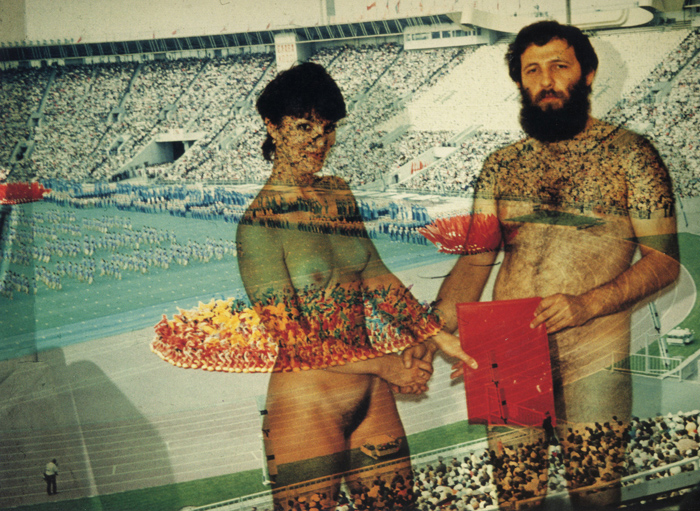Boris Mikhailov
 © Boris Mikhailov
© Boris Mikhailov
About The Artist:
Boris Mikhailov (b. 1938, lives in Kharkov and Berlin) is the artist who put the city of Kharkov on the world photography map. A Hasselblad Prize laureate, an artist whose work has been exhibited in most prestigious world galleries, was the engine of the Vremya group and the key figure in the emergence of the Kharkiv School of Photography. On a continuous search of new ideas, always discontented with the result and demanding more from his own work, he was the creator of the most important words in the new visual language of the Kharkiv School.
‘Overlays’ (1968 – 1978), or ‘superimpositions’, or ‘sandwiches’, as the artist sometimes called them, were probably Boris Mikhailov’s first invention on the way to the new and more complex means of visual language. Two overimposed color slide film frames were either projected on a screen as a slide show or printed on color photopaper. The technique produced a result similar to multiexposure, but allowed clearer detailing and combinatory possibilities. The images looked formally new, surrealistic and grotesque. Mikhailov's work in this technique, as in all his oeuvre, has acute social focus.
Mikhailov's 'Red Series' (1965 – 1978) assigned an additional meaning to the red color favored by the Communist party's decorators, making it the color of feigned loyalty and simulated enthusiasm. Even innocently occasional red objects in this work appear repulsive and annoying.
Later (in 1978?) Boris Mikhailov offered a conceptual alternative to sophisticated techniques of other Vremya artists. He claimed that a high quality glossy image was unable to depict the Soviet reality with its poor life standards (including poor quality of Soviet-made film, paper and chemicals), and suggested the concept of ‘bad photography for bad reality’ instead: small sloppily printed black-and-white photos, often blurred, low contrast, showing film defects or perforation. ‘Mikhailov introduced “bad photography” as a method to undermine the Soviet compositional canon and the optimistic narrative that the canon served to represent. For Mikhailov, depicting the Soviet reality at the moment of its irreversible and violent break-up, “bad photography” became a tool of aesthetic and social critique’ (Iryna Sandomirskaya).
This method was later used in Mikhailov’s famous The Unfinished Dissertation (1984 – 1985, published in 1998), where black-and-white images pasted on the back of someone’s lecture notes were accompanied by hand-written comments, autobiographical and philosophical notes, etc. Margarita Tupitsyn wrote in an essay appended to the book, “Mikhailov saw no point in providing an explicit critique of Soviet society, either through mocking it or through unmasking its endless vices. Instead, his goal was to preserve Soviet reality’s sense of totality, but without its layer of systematically sustained external joy.”
(In the early 1990-s Boris Mikhailov made a significant contribution to his ‘bad photography’ concept. Two large documentary series of chemically toned black-and-white images. At Dusk (1993) and By the Ground (1991), a.k.a. The Blue and The Brown Series, used stains and other defects of color toning as a visual representation of deteriorating life standards of post-Soviet reality. We are planning to exhibit At Dusk and By the Ground in the second part of this project.)
In the 1970-s photographers often earned a living by copying and enlarging people’s family photographs. It was an illegal commercial practice commissioned by people living in rural areas, often in remote parts of the country where color studio photography was either too expensive or simply non-existent. A specifically Soviet product, called a lurik, was a mounted or framed enlarged and retouched hand-colored portrait, postmortem portraits included. Family or passport photos by origin, these desperate examples of true folk art sometimes included instructions: to remove a hat or add more hair, to make a montage coupling two people in one photo of a would-be family, etc. Boris Mikhailov conceptualized this technique in his famous Luriki series (1971 – 1985), 'the first strategic use of found material in contemporary Soviet photography' (John P. Jacobs).
Boris Mikhailov Portfolios 1970-1980s
Bad Photography
The Unfinished Dissertation
Luriki
Overlays
Red Series
We welcome your comments. VASA Exhibitions are the result of various curators, artist, and photographers.